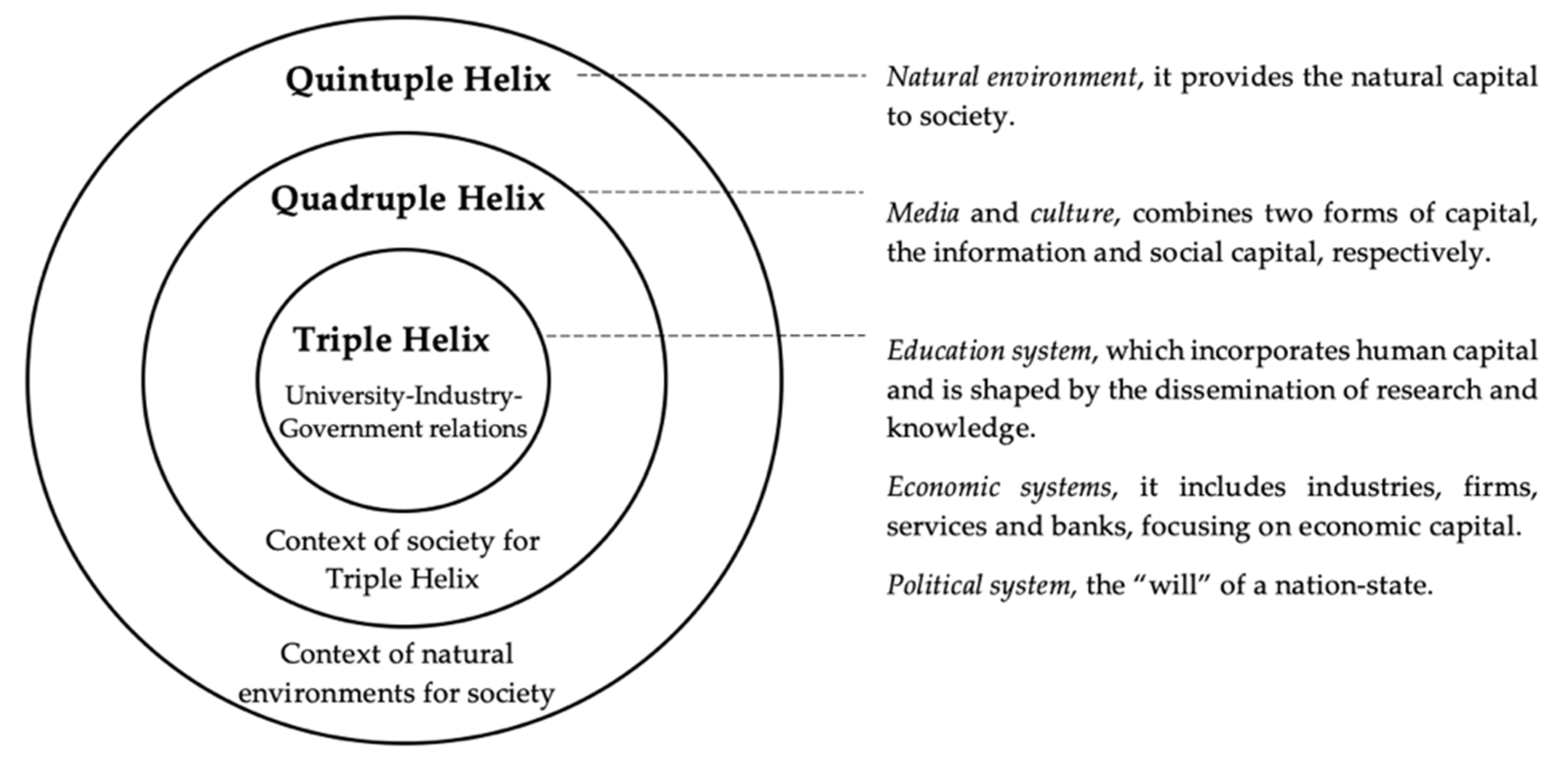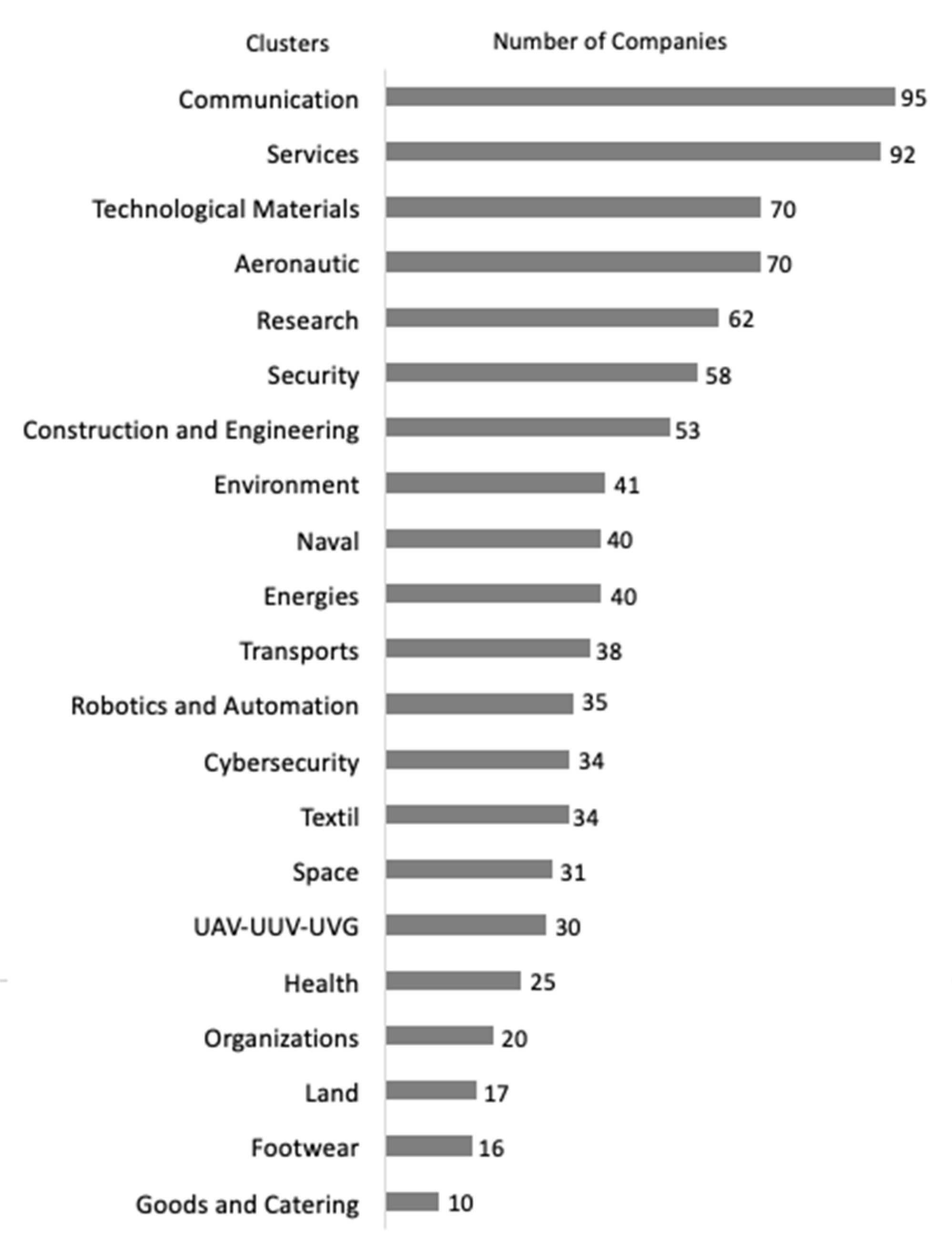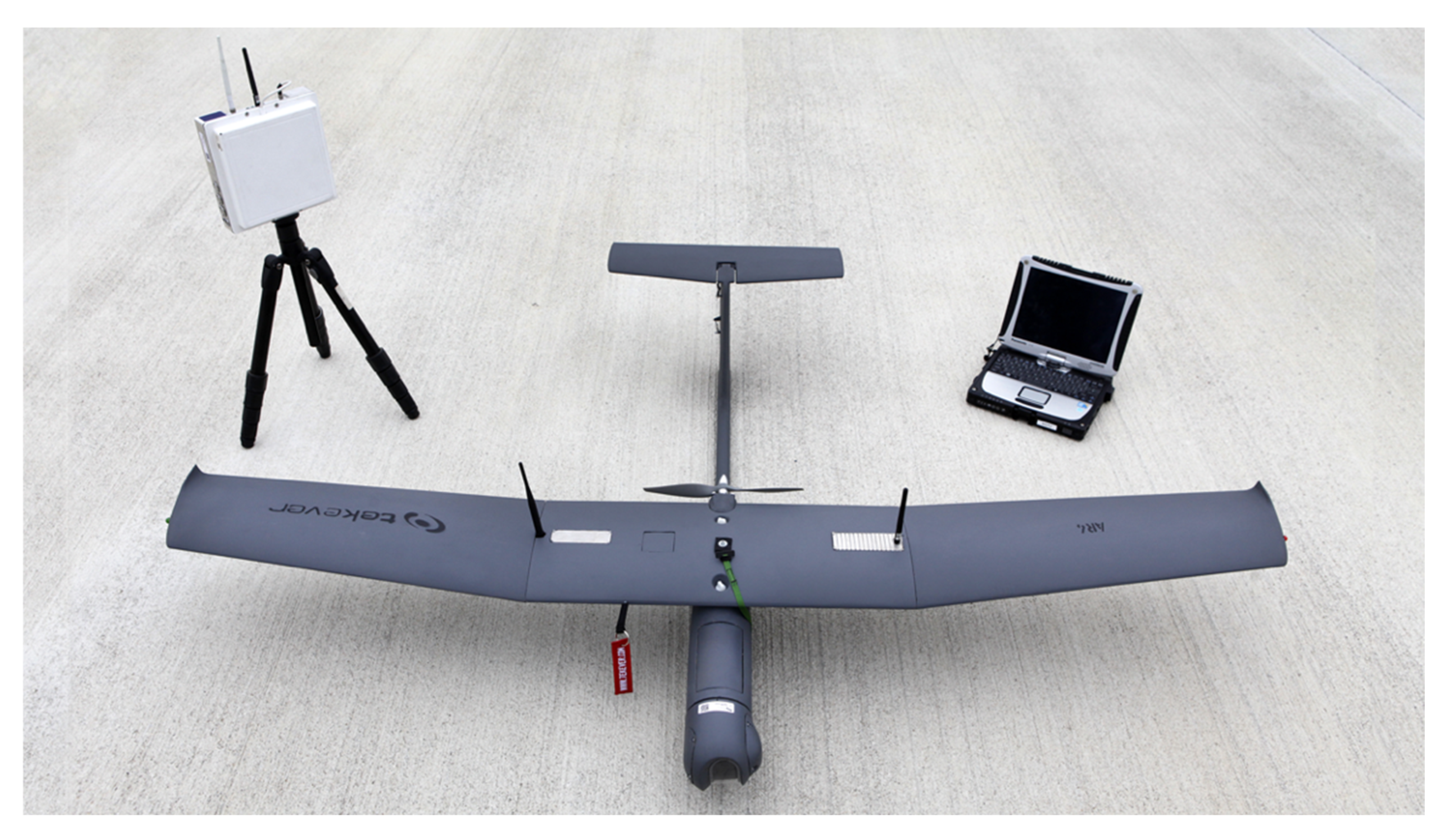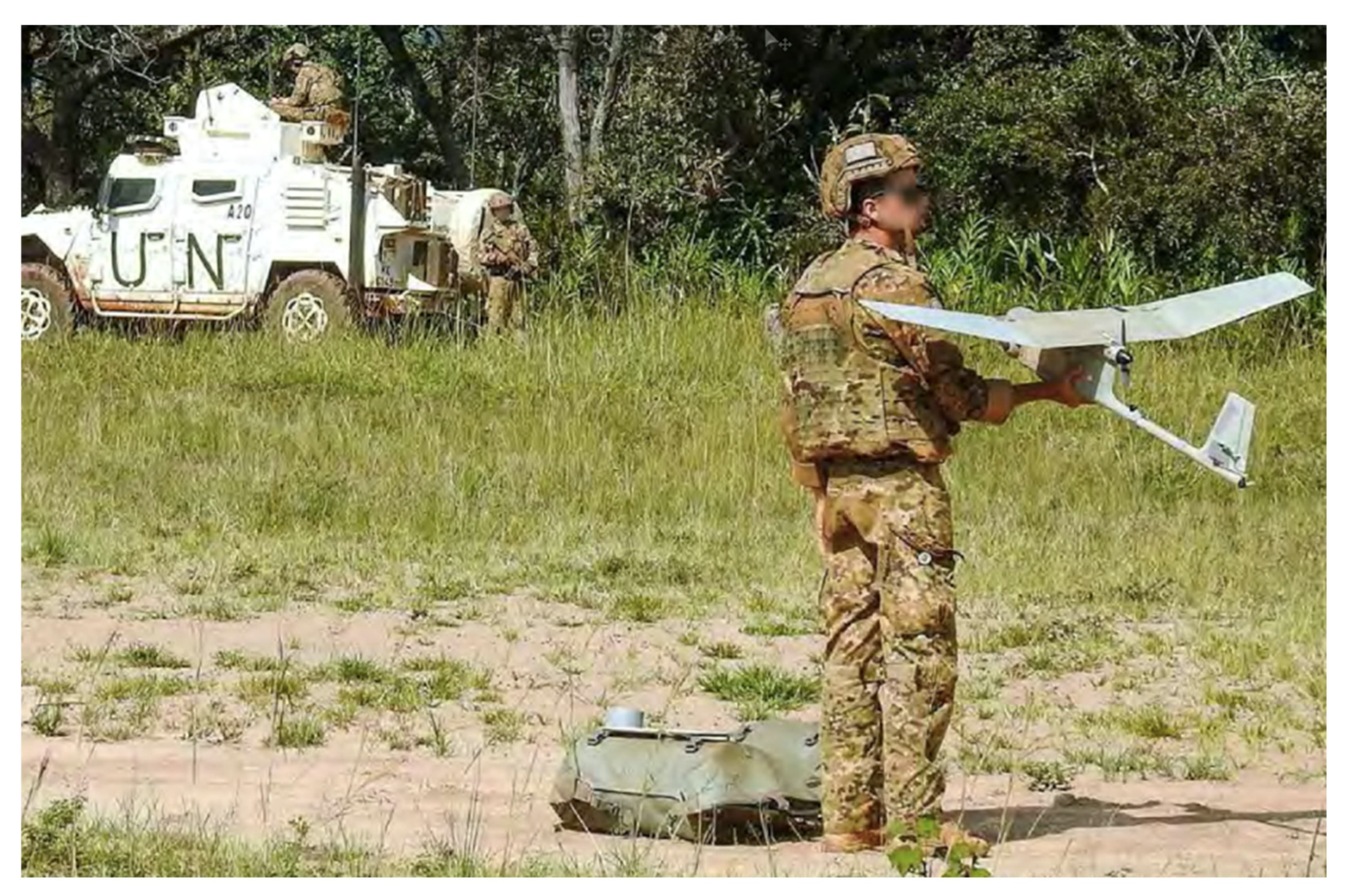Quintuple Helix Innovation Model for the European Union Defense Industry—An Empirical Research
Abstract
1. Introduction
2. Conceptual Background
2.1. Triple Helix, Quadruple Helix, Quintuple Helix and N-Tuple of Helices
2.2. Defense Industry—Is the Traditional Quintuple Helix Model Enough?
3. Methodology
4. Results and Discussion
4.1. The Portuguese DTIB
4.1.1. Case Study 1—TEKEVER (Unmanned Aerial Vehicles)
4.1.2. Case Study 2—Projects AuxDefense (Advanced Materials for Defense), ACU (Advanced Combat Uniform) and SCS (Soldier´s Combat System)
4.1.3. Case Study 3—Warfare Ecology
4.2. Empirical Model for the Defense Industry
5. Conclusions
5.1. Political Contributions
5.2. Theoretical and Managerial Contributions
5.3. Limitations and Recommendations for Future Research
Author Contributions
Funding
Institutional Review Board Statement
Informed Consent Statement
Data Availability Statement
Acknowledgments
Conflicts of Interest
References
- Reis, J. Politics, Power, and Influence: Defense Industries in the Post-Cold War. Soc. Sci. 2021, 10, 10. [Google Scholar] [CrossRef]
- Simões, P.C.; Moreira, A.C.; Mendes Dias, C. Portugal’s Changing Defense Industry: Is the Triple Helix Model of Knowledge Society Replacing State Leadership Model? J. Open Innov. Technol. Mark. Complex. 2020, 6, 183. [Google Scholar] [CrossRef]
- Sezal, M.A.; Giumelli, F. Technology Transfer and Defence Sector Dynamics: The Case of the Netherlands. Eur. Secur. 2022, 31, 558–575. [Google Scholar] [CrossRef]
- Kollias, C. A Preliminary Investigation of the Burden Sharing Aspects of a European Union Common Defence Policy. Def. Peace Econ. 2008, 19, 253–263. [Google Scholar] [CrossRef]
- Larivé, M.H.A. Debating European Security and Defense Policy; Routledge: Oxfordshire, UK, 2016; ISBN 978-1-317-15430-3. [Google Scholar]
- Kolin, V. Towards Balanced Defence Industry in Europe: Main Specificities of Central and Eastern European Defence Industries. IRIS Notes 2015, 1–15. Available online: https://www.iris-france.org/wp-content/uploads/2015/03/IRIS-Note-March-2015-V-Kolin1.pdf (accessed on 31 October 2022).
- Sharma, A.; Sousa, C.; Woodward, R. Determinants of Innovation Outcomes: The Role of Institutional Quality. Technovation 2022, 118, 102562. [Google Scholar] [CrossRef]
- Huizingh, E.K.R.E. Open Innovation: State of the Art and Future Perspectives. Technovation 2011, 31, 2–9. [Google Scholar] [CrossRef]
- Chesbrough, H.W. Open Innovation: The New Imperative for Creating and Profiting from Technology; Harvard Business School Press: Boston, MA, USA, 2011; ISBN 978-1-4221-0283-1. [Google Scholar]
- Chesbrough, H.; Bogers, M. Explicating Open Innovation. In New Frontiers in Open Innovation; Chesbrough, H., Vanhaverbeke, W., West, J., Eds.; Oxford University Press: Oxford, UK, 2014; pp. 3–28. ISBN 978-0-19-968246-1. [Google Scholar]
- Madanaguli, A.; Dhir, A.; Talwar, S.; Clauss, T.; Kraus, S.; Kaur, P. Diving into the Uncertainties of Open Innovation: A Systematic Review of Risks to Uncover Pertinent Typologies and Unexplored Horizons. Technovation 2022, 119, 102582. [Google Scholar] [CrossRef]
- Chesbrough, H. Managing Open Innovation. Res.-Technol. Manag. 2004, 47, 23–26. [Google Scholar] [CrossRef]
- Leydesdorff, L.; Ivanova, I. “Open Innovation” and “Triple Helix” Models of Innovation: Can Synergy in Innovation Systems Be Measured? J. Open Innov. 2016, 2, 11. [Google Scholar] [CrossRef]
- Zhou, C.; Etzkowitz, H. Triple Helix Twins: A Framework for Achieving Innovation and UN Sustainable Development Goals. Sustainability 2021, 13, 6535. [Google Scholar] [CrossRef]
- Etzkowitz, H. Triple Helix: A Universal Innovation Model? In Handbook on Science and Public Policy; Edward Elgar Publishing: Cheltenham, UK, 2019; pp. 357–375. ISBN 978-1-78471-594-6. [Google Scholar]
- Cai, Y.; Lattu, A. Triple Helix or Quadruple Helix: Which Model of Innovation to Choose for Empirical Studies? Minerva 2022, 60, 257–280. [Google Scholar] [CrossRef]
- Langlois, J.; Ben Mahmoud-Jouini, S.; Servajean-Hilst, R. Secrecy in Open Innovation and Open Innovation in Secrecy. SSRN J. 2020. [Google Scholar] [CrossRef]
- Langlois, J.; BenMahmoud-Jouini, S.; Servajean-Hilst, R. Practicing Secrecy in Open Innovation—The Case of a Military Firm. Res. Policy 2023, 52, 104626. [Google Scholar] [CrossRef]
- Fernández Lorenzo, A.; Paredes Calderón, D.M.; Parra Cárdenas, H.A. Procedure to Identify Actors That Revitalize an Incipient Defense Industry Under the Five-Helix Approach. In Artificial Intelligence, Computer and Software Engineering Advances; Advances in Intelligent Systems and Computing; Botto-Tobar, M., Cruz, H., Díaz Cadena, A., Eds.; Springer International Publishing: Cham, Switzerland, 2021; Volume 1327, pp. 82–95. ISBN 978-3-030-68082-4. [Google Scholar]
- Reis, J.; Melão, N.; Costa, J.; Pernica, B. Defence Industries and Open Innovation: Ways to Increase Military Capabilities of the Portuguese Ground Forces. Def. Stud. 2022, 22, 354–377. [Google Scholar] [CrossRef]
- Leydesdorff, L. The Triple Helix, Quadruple Helix, …, and an N-Tuple of Helices: Explanatory Models for Analyzing the Knowledge-Based Economy? J. Knowl. Econ. 2012, 3, 25–35. [Google Scholar] [CrossRef]
- Lew, Y.K.; Park, J. The Evolution of N-helix of the Regional Innovation System: Implications for Sustainability. Sustain. Dev. 2021, 29, 453–464. [Google Scholar] [CrossRef]
- Etzkowitz, H.; Leydesdorff, L. The Dynamics of Innovation: From National Systems and “Mode 2” to a Triple Helix of University–Industry–Government Relations. Res. Policy 2000, 29, 109–123. [Google Scholar] [CrossRef]
- Etzkowitz, H.; Leydesdorff, L. A Triple Helix of University—Industry—Government Relations: Introduction. Ind. High. Educ. 1998, 12, 197–201. [Google Scholar] [CrossRef]
- Carayannis, E.G.; Campbell, D.F.J. “Mode 3” and “Quadruple Helix”: Toward a 21st Century Fractal Innovation Ecosystem. IJTM 2009, 46, 201. [Google Scholar] [CrossRef]
- Carayannis, E.G.; Barth, T.D.; Campbell, D.F. The Quintuple Helix Innovation Model: Global Warming as a Challenge and Driver for Innovation. J. Innov. Entrep. 2012, 1, 2. [Google Scholar] [CrossRef]
- Jovanović, M.; Savić, G.; Cai, Y.; Levi-Jakšić, M. Towards a Triple Helix Based Efficiency Index of Innovation Systems. Scientometrics 2022, 127, 2577–2609. [Google Scholar] [CrossRef] [PubMed]
- Carayannis, E.G.; Campbell, D.F.J.; Grigoroudis, E. Helix Trilogy: The Triple, Quadruple, and Quintuple Innovation Helices from a Theory, Policy, and Practice Set of Perspectives. J. Knowl. Econ. 2022, 13, 2272–2301. [Google Scholar] [CrossRef]
- Carayannis, E.G.; Campbell, D.F. Editorial Preface to the First Volume of Journal of Innovation and Entrepreneurship. J. Innov. Entrep. 2012, 1, 1. [Google Scholar] [CrossRef]
- Leydesdorff, L. N-Tuple of Helices. In Encyclopedia of Creativity, Invention, Innovation and Entrepreneurship; Carayannis, E.G., Ed.; Springer: New York, NY, USA, 2013; pp. 1400–1402. ISBN 978-1-4614-3857-1. [Google Scholar]
- Koshovets, O.B.; Frolov, I.E. Institute of Philosophy, Russian Academy of Sciences Brave New World: On Science Transformation Into Technoscience. Epistemol. Philos. Sci. 2020, 57, 20–31. [Google Scholar] [CrossRef]
- Reis, J.; Cohen, Y.; Melão, N.; Costa, J.; Jorge, D. High-Tech Defense Industries: Developing Autonomous Intelligent Systems. Appl. Sci. 2021, 11, 4920. [Google Scholar] [CrossRef]
- Billing, D.C.; Fordy, G.R.; Friedl, K.E.; Hasselstrøm, H. The Implications of Emerging Technology on Military Human Performance Research Priorities. J. Sci. Med. Sport 2021, 24, 947–953. [Google Scholar] [CrossRef]
- Matejka, J. Robot as a Member of Combat UnitA Utopia or Reality for Ground Forces? AiMT 2020, 15, 7–24. [Google Scholar] [CrossRef]
- Kunertova, D. From Robots to Warbots: Reality Meets Science Fiction. CSS Anal. Secur. Policy 2021, 292, 4. [Google Scholar] [CrossRef]
- Qayyum, U.; Anjum, S.; Sabir, S. Armed Conflict, Militarization and Ecological Footprint: Empirical Evidence from South Asia. J. Clean. Prod. 2021, 281, 125299. [Google Scholar] [CrossRef]
- Antunes, J.C.; Moreira, I.P.; Gomes, F.; Cunha, F.; Henriques, M.; Fangueiro, R. Recent Trends in Protective Textiles against Biological Threats: A Focus on Biological Warfare Agents. Polymers 2022, 14, 1599. [Google Scholar] [CrossRef] [PubMed]
- Fangueiro, R.; Rana, S. (Eds.) Advanced Materials for Defense: Development, Analysis and Applications; Springer Proceedings in Materials; Springer International Publishing: Cham, Switzerland, 2020; Volume 4, ISBN 978-3-030-34122-0. [Google Scholar]
- Yin, R.K. Case Study Research: Design and Methods, 4th ed.; Applied social research methods; Sage Publications: Los Angeles, CA, USA, 2009; ISBN 978-1-4129-6099-1. [Google Scholar]
- Etikan, I. Comparison of Convenience Sampling and Purposive Sampling. AJTAS 2016, 5, 1. [Google Scholar] [CrossRef]
- Robinson, O.C. Sampling in Interview-Based Qualitative Research: A Theoretical and Practical Guide. Qual. Res. Psychol. 2014, 11, 25–41. [Google Scholar] [CrossRef]
- idD Portugal Portuguese Defence Technological and Industrial Base. 2022. Available online: https://www.Iddportugal.Pt/Wp-Content/Uploads/2018/07/Booklet-PortugueseDTIB_Farnborough2018_UK.Pdf (accessed on 19 August 2022).
- Martinho, B.; Reis, J. United Nations (UN) Disaster Risk Reduction Framework: Case Study of the Portuguese Army on UN Challenges in the Context of Sustainable Risk Mitigation. Sustainability 2022, 14, 1834. [Google Scholar] [CrossRef]
- Turner, D. Qualitative Interview Design: A Practical Guide for Novice Investigators. TQR 2014, 15, 754–760. [Google Scholar] [CrossRef]
- Castillo-Montoya, M. Preparing for Interview Research: The Interview Protocol Refinement Framework. TQR 2016, 21, 811–831. [Google Scholar] [CrossRef]
- Callado-Muñoz, F.J.; Fernández-Olmos, M.; Ramírez-Alesón, M.; Utrero-González, N. Characterisation of Technological Collaborations and Evolution in the Spanish Defence Industry. Def. Peace Econ. 2022, 33, 219–238. [Google Scholar] [CrossRef]
- Lawrence, M.J.; Stemberger, H.L.J.; Zolderdo, A.J.; Struthers, D.P.; Cooke, S.J. The Effects of Modern War and Military Activities on Biodiversity and the Environment. Environ. Rev. 2015, 23, 443–460. [Google Scholar] [CrossRef]
- Marshall, M.N. Sampling for Qualitative Research. Fam. Pract. 1996, 13, 522–526. [Google Scholar] [CrossRef]
- Parker, C.; Scott, S.; Geddes, A. Snowball Sampling. In SAGE Research Methods Foundations; SAGE Publications Ltd.: London, UK, 2020; ISBN 978-1-5264-2103-6. [Google Scholar]
- Mills, A.; Durepos, G.; Wiebe, E. Encyclopedia of Case Study Research; SAGE Publications, Inc.: Thousand Oaks, CA, USA, 2010; ISBN 978-1-4129-5670-3. [Google Scholar]
- Scott, R.A.; Kosslyn, S.M.; Buchmann, M. Emerging Trends in the Social and Behavioral Sciences: An Interdisciplinary, Searchable, and Linkable Resource; John Wiley & Sons: Hoboken, NJ, USA, 2015; ISBN 978-1-118-90077-2. [Google Scholar]
- Wong, L. Data Analysis in Qualitative Research: A Brief Guide to Using NVivo. Malays. Fam. Physician Off. J. Acad. Fam. Physicians Malays. 2008, 3, 14–20. [Google Scholar]
- Reis, J.; Marques, P.A.; Marques, P.C. Where Are Smart Cities Heading? A Meta-Review and Guidelines for Future Research. Appl. Sci. 2022, 12, 8328. [Google Scholar] [CrossRef]
- John, W.S.; Johnson, P. The Pros and Cons of Data Analysis Software for Qualitative Research. J. Nurs. Scholarsh. 2000, 32, 393–397. [Google Scholar] [CrossRef] [PubMed]
- idD Portugal Defence. Portugal: Making the Difference. Available online: https://Btid.Iddportugal.Pt/about-Dtib/ (accessed on 2 August 2022).
- TEKEVER. Tekever AR4. Available online: http://Uas.Tekever.Com/Ar4-Evo/ (accessed on 12 August 2022).
- RQ-11B Raven. Battlefield Surveillance. Available online: https://www.Exercito.Pt/Pt/Meios/Equipamentos?Menu=vigilancia-Batalha (accessed on 20 August 2022).
- Portugal.Gov. Clarification of the National Defense on the Acquisition of Drones. Available online: https://www.Portugal.Gov.Pt/Pt/Gc22/Comunicacao/Comunicado?I=esclarecimento-Da-Defesa-Nacional-Sobre-a-Aquisicao-de-Drones (accessed on 12 August 2022).
- Stoneman, P. Handbook of the Economics of Innovations and Technological Change; Blackwell Handbooks in Economics; Blackwell: Oxford, UK; Cambridge, MA, USA, 1995; ISBN 978-0-631-17773-9. [Google Scholar]
- Rana, S.; Fangueiro, R. Advanced Composite Materials for Aerospace Engineering: Processing, Properties and Applications; Woodhead Publishing Series in Composites Science and Engineering; Elsevier/Woodhead Publishing: Amsterdam, The Netherlands, 2016; ISBN 978-0-08-100054-0. [Google Scholar]
- Army Magazine. Acquisitions in the Army. Available online: https://Assets.Exercito.Pt/SiteAssets/JE/Jornais/2021/Jul_ago21/JE711.Aspx (accessed on 12 August 2022).
- Santos, G.; Barros, A.; Oliveira, C.; Ferreira, P. Smart Acclimatization Textile Systems for Defence. KEM 2019, 812, 25–37. [Google Scholar] [CrossRef]
- Skalny, A.V.; Aschner, M.; Bobrovnitsky, I.P.; Chen, P.; Tsatsakis, A.; Paoliello, M.M.B.; Buha Djordevic, A.; Tinkov, A.A. Environmental and Health Hazards of Military Metal Pollution. Environ. Res. 2021, 201, 111568. [Google Scholar] [CrossRef]
- idD Portugal D3. Demilitarization and Deactivation of Energy Materials. 2022. Available online: Https://Www.Iddportugal.Pt/a-Idd/Desmilitarizacao/ (accessed on 12 July 2022).
- National Defense. “Simplex” in Demilitarization, Dismantling and Disposal of Equipment and Weapons Systems. 2017. Available online: https://www.Defesa.Gov.Pt/Pt/Comunicacao/Noticias_fa/Paginas/Simplex-Na-Desmilitarizacao-Desmantelamento-e-Alienacao-de-Equipamentos-e-Sistemas-de-Armas.Aspx (accessed on 2 August 2022).
- Reis, J.; Rosado, D.P.; Cohen, Y.; Pousa, C.; Cavalieri, A. Green Defense Industries in the European Union: The Case of the Battle Dress Uniform for Circular Economy. Sustainability 2022, 14, 13018. [Google Scholar] [CrossRef]
- da Silva, M.V.G.; Olavo-Quandt, C. Defense System, Industry and Academy: The Conceptual Model of Innovation of the Brazilian Army. J. Technol. Manag. Innov. 2019, 14, 53–62. [Google Scholar] [CrossRef][Green Version]
- Christensen, C.; Salmon, J. Principles for Small-Unit SUAS Tactical Deployment from a Combat-Simulating Agent-Based Model Analysis. Expert Syst. Appl. 2022, 190, 116156. [Google Scholar] [CrossRef]
- Chovančík, M. Defense Industrialization in Small Countries: Policies in Czechia and Slovakia. Comp. Strategy 2018, 37, 272–285. [Google Scholar] [CrossRef]
- Cowen, R.H.E. Defense Procurement in the Federal Republic of Germany: Politics and Organization, 1st ed.; Routledge: New York, NY, USA, 2021; ISBN 978-0-429-04056-6. [Google Scholar]
- Türkalp, S.; Dekkers, B. Case: Sharing Parts and Services Among NATO Members. In NL ARMS Netherlands Annual Review of Military Studies 2021; Beeres, R., Bertrand, R., Klomp, J., Timmermans, J., Voetelink, J., Eds.; NL ARMS; T.M.C. Asser Press: The Hague, The Netherlands, 2022; pp. 175–186. ISBN 978-94-6265-470-9. [Google Scholar]
- Fiott, D. Reducing the Environmental Bootprint? Competition and Regulation in the Greening of Europe’s Defense Sector. Organ. Environ. 2014, 27, 263–278. [Google Scholar] [CrossRef]





| Military/Rank | Quantity | Position (Place) | Interview Date |
|---|---|---|---|
| Lieutenant Colonel (OF-5) | 2 | NATO HQ Staff (Middle East) | April–May 2022 |
| Major (OF-4) | 3 | NATO HQ Staff (Middle East) | March–April 2022 |
| Lieutenant (OF-2) | 2 | Command, Training Role (Middle East) | February 2022 |
| Sergeant First Class (OR-6) | 2 | Command, Training Role (Middle East) | February 2022 |
| Sergeant First Class (OR-6) | 2 | UAV Operator (Central Africa) | July 2022 |
| Experts/Job Title | Quantity | Duty (Place) | Interview Date |
| Academic/Researcher | 1 | Full Professor (University, Portugal/EU) | March 2022 |
| Academic/Researcher | 1 | Assistant Professor (University, Portugal/EU) | March 2022 |
| Manager/Expert | 2 | NATO Air Defense Systems Support and Supply (NSPA, Luxemburg/EU) | July 2022 |
| Director/Expert | 1 | Executive Director (Private company, Portugal/EU) | March 2022 |
| Manager/Expert | 2 | Project Manager (Private company, Portugal/EU) | March–April 2022 |
| Activity | Quantity | Type (Place) | Direct observation date |
| Round Table | 1 | First study on Defense Economy in Portugal (National Defense Institute, Portugal/EU) | December 2021 |
| Seminar | 1 | European Defense Fund (Webinar) | February 2022 |
| Seminar | 1 | NATO 360°: Business and development opportunities (Webinar) | April 2022 |
| Seminar | 1 | European Defense Fund: Challenges and Opportunities (Portuguese Military Academy, Portugal/EU) | April 2022 |
| Type | Quantity | Title | Official Documents (Publication Date) |
| Report, NATO HQ Staff | 3 | End of tour and mission reports | 2017–2022 |
| Report, idD Portugal | 1 | Defense Industrial Capabilities in Portugal/EU | July 2022 |
| Report, idD Portugal | 1 | Demilitarization and Deactivation of Energy Materials | July 2022 |
| Methodological Process | Approach | ||
|---|---|---|---|
| Research nature: | Qualitative research | ||
| Research strategy: | Literature review | Embedded case study research | |
| (Sub)unit of analysis: | Not applicable | TEKEVER Projects AuxDefense, ACU and SCS Warfare ecology | |
| Sources of data collection: | Scopus database | Semi-structured interview Direct observation Official documents | |
| Data analysis technique: | Full article reading for a holistic understanding | Content analysis | |
| Coding approach: | Not applicable | Inductive | |
Publisher’s Note: MDPI stays neutral with regard to jurisdictional claims in published maps and institutional affiliations. |
© 2022 by the authors. Licensee MDPI, Basel, Switzerland. This article is an open access article distributed under the terms and conditions of the Creative Commons Attribution (CC BY) license (https://creativecommons.org/licenses/by/4.0/).
Share and Cite
Reis, J.; Rosado, D.P.; Ribeiro, D.F.; Melão, N. Quintuple Helix Innovation Model for the European Union Defense Industry—An Empirical Research. Sustainability 2022, 14, 16499. https://doi.org/10.3390/su142416499
Reis J, Rosado DP, Ribeiro DF, Melão N. Quintuple Helix Innovation Model for the European Union Defense Industry—An Empirical Research. Sustainability. 2022; 14(24):16499. https://doi.org/10.3390/su142416499
Chicago/Turabian StyleReis, João, David Pascoal Rosado, Diogo Freitas Ribeiro, and Nuno Melão. 2022. "Quintuple Helix Innovation Model for the European Union Defense Industry—An Empirical Research" Sustainability 14, no. 24: 16499. https://doi.org/10.3390/su142416499
APA StyleReis, J., Rosado, D. P., Ribeiro, D. F., & Melão, N. (2022). Quintuple Helix Innovation Model for the European Union Defense Industry—An Empirical Research. Sustainability, 14(24), 16499. https://doi.org/10.3390/su142416499








